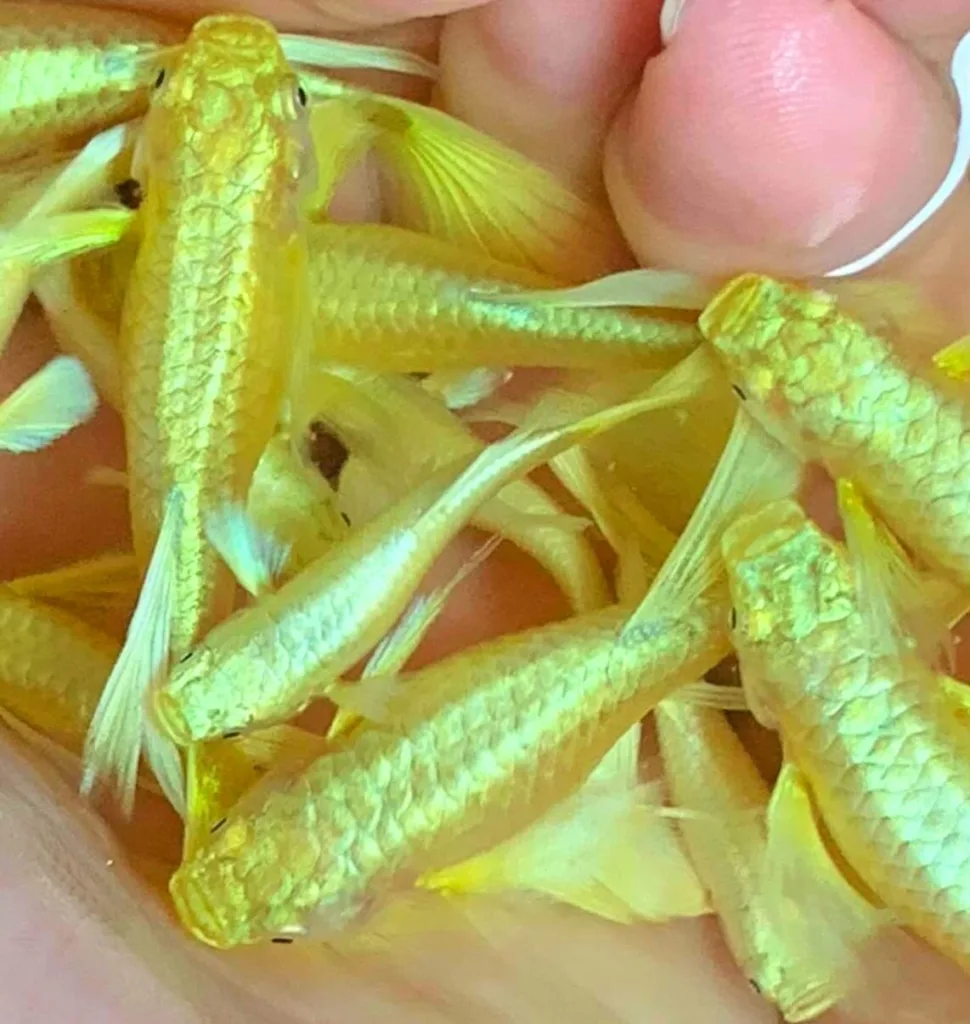
A Full Gold guppy typically refers to a type of guppy fish (Poecilia reticulata) that displays a predominantly gold or yellow coloration in its scales. Guppies are a popular and colorful tropical fish species that come in various color and pattern variations due to selective breeding by freshwater fish hobbyists over many years.
Full gold guppies have a body and fins that are primarily golden in color, and they may exhibit varying degrees of color intensity and shading. These easy-to-care-fore fish are prized for their bright and eye-catching appearance in aquariums. Guppies are relatively easy to care for and are commonly kept in home aquariums due to their vibrant colors and lively behavior.
Key Characteristics and Care Guidelines
- Appearance: Full gold guppies have a predominantly golden or yellow body and fins. The entire body is characterized by a rich metallic gold or yellow coloration. This guppy variety typically does not display distinct color patterns and maintains a uniform golden hue.
- Size: Full gold guppies are small fish. Females grow to about 2-2.5 inches (5-6.4 centimeters) in length, while males are slightly smaller.
- Tank size: A minimum of 10 gallons for a group of 6 fish.
- Diet: They are omnivorous and accept a wide range of foods. Their diet should include high-quality flake or pellet food, supplemented with live or frozen foods like brine shrimp, daphnia, and bloodworms.
- Origin: Full gold guppies, like other guppy variations, have been selectively bred over many years by hobbyists and breeders. They are not a natural species but rather a result of selective breeding within the guppy species.
- Lifespan: Gold guppies typically have a lifespan of about 2-3 years in well-maintained aquarium conditions.
- Social Behavior: Peaceful, Schooling fish that swims in the top half of the water column.
Full Gold Guppy Care Guide
Recommended aquarium water parameters
The recommended water parameters for keeping full gold guppies (and most guppy varieties) in an aquarium are as follows:
- Water Temperature: Maintain the water temperature between 72-78 degrees Fahrenheit (22-25 degrees Celsius). Guppies are tropical fish and thrive in the slightly warmer range, but they can tolerate minor fluctuations within this range.
- pH Level: Keep the pH level in the range of 6.5-7.5. Guppies are adaptable and can tolerate a slightly acidic to slightly alkaline pH. However, they tend to do best in slightly alkaline conditions.
- Water Hardness (dGH): Aim for a water hardness (measured in degrees of General Hardness, dGH) of 9-12 dGH. Guppies can adapt to a range of water hardness levels, but they often do well in moderately hard water.
- Nitrite: Ideally, you should maintain nitrite levels at or near zero in your aquarium.
- Nitrate: In a well-maintained aquarium, nitrate levels should be kept below 20-40 parts per million (ppm), with lower levels being better.
It’s important to note that water quality is crucial for the health and well-being of guppies. Regular water changes, good filtration, and maintaining stable water parameters are essential. Additionally, keep an eye on the ammonia, nitrite, and nitrate levels in the aquarium, as these can have a significant impact on the health of your guppies. Maintain low ammonia and nitrite levels and keep nitrates at a reasonable level through regular water changes.
Lastly, guppies are hardy and adaptable fish, so they can tolerate slight variations in water parameters. However, it’s still best to strive for the recommended conditions to ensure the health and longevity of your guppies.
Tank Size
The best size tank for a Full Gold guppy is a 10 gallon size tank if you have a group of less than 5 fish. If you plan on having more than 5 fish you should move up to a larger tank like a 20 gallon to 55 gallon tank. The larger the tank the easier it is to keep the water clean and clear.
Filtration
Water quality is the most important part of keeping fish in your Full Gold guppy tank. One of the best options is the Fluval Aquaclear Power Filter, known for its reliability and customizable filtration. Another excellent choice is the Eheim Classic External Canister Filter, its quiet operation and efficient mechanical and biological filtration.
Substrate Choices:
For substrate, consider choosing fine gravel, aqua soil or sand. These options are ideal as they are easy to clean, provide a natural appearance, and allow for the rooting of live plants.
Plant Selection:
The best plants for a guppy tank are those that are easy to care for, provide plenty of hiding places for fry, and don’t require a lot of light. Here are a few of the most popular choices:
- Java moss: Java moss is a very hardy plant that can thrive in a variety of conditions. It is also very good at providing hiding places for fry
- Anacharis: Anacharis is a fast-growing plant that can help to improve water quality. It is also a good choice for guppy tanks because it provides plenty of hiding places for fry.
- Hornwort: Hornwort is another fast-growing plant that is easy to care for. It is also a good choice for guppy tanks because it provides plenty of hiding places for fry.
- Water wisteria: Water wisteria is a beautiful plant that can add a lot of interest to a guppy tank. It is also a good choice for guppy tanks because it provides plenty of hiding places for fry.
- Amazon sword: Amazon sword is a popular choice for guppy tanks because it is easy to care for and provides plenty of hiding places for fry. It is also a good choice for larger guppy tanks.
Steps for setting up your tank :
- Choose a location for your tank. The tank should be placed in a level spot where it will not receive direct sunlight.
- Clean the tank. Rinse the tank with water to remove any dust or debris. Do not use soap or detergent, as this can be harmful to fish.
- Add the substrate. Add a 2-3 inch layer of substrate to the bottom of the tank.
- Add the decorations. Rinse the decorations thoroughly before adding them to the tank. Be careful not to overcrowd the tank with decorations, as guppies need plenty of swimming space.
- Fill the tank with water. Use dechlorinated water to fill the tank. You can use a water conditioner to remove chlorine and other harmful chemicals from the water.
- Install the filter, heater, and air pump. Follow the manufacturer’s instructions to install the equipment.
- Cycle the tank. This involves establishing a colony of beneficial bacteria in the tank. The bacteria will help to break down fish waste and other toxins
- Test the water. Once the tank has cycled, test the water to make sure that the parameters are within the safe range for guppies. The ideal water temperature for guppies is 72-78 degrees Fahrenheit. The pH should be between 6.5 and 7.5 with <0 Nitrates and Nitrites
- Add the guppies. Start by adding a few guppies to the tank and monitor them closely for any signs of stress. If the guppies seem to be doing well, you can add more fish to the tank gradually.
Tank Mates
Full Gold guppy are peaceful fish that can be kept with other community fish of similar size and temperament. Some good tankmates for Full Gold guppy include:

- Neon tetras
- Other Breeds of guppies
- Zebra danios
- Corydoras catfish
- Platies
- Swordtails
- Mollies
Breeding
Breeding Full Gold guppies is relatively easy in a home aquarium. If you are interested in breeding guppies, it is important to have a separate breeding tank. The breeding tank should be planted with floating plants to provide cover for the fry.
To breed Full Gold guppies simply place a male and female guppy in the breeding tank. The female will become pregnant within a few days. The gestation period for guppies is around 21 to 30 days.
Once the female guppy is pregnant, she will develop a dark spot on her abdomen. This spot is called the gravid spot and it is a sign that the female is close to giving birth.
When the female guppy is ready to give birth, she will isolate herself from the other fish. She will then give birth to live fry. The fry will be very small and will need to be fed a diet of infusoria or baby brine shrimp until they are large enough to eat regular food.
Here are some additional tips for breeding Full Gold guppies
- Use healthy and well-fed fish for breeding.
- Keep the breeding tank clean and well-maintained.
- Provide the fish with a variety of foods to ensure that they are getting the nutrients they need.
- Remove the male guppy from the breeding tank after the female is pregnant.
- Feed the fry a diet of infusoria or baby brine shrimp until they are large enough to eat regular food.
Where to buy and average price
Full Gold guppies can be purchased from a variety of sources, including:
- Local fish stores: This is a great option if you want to see the fish in person before you buy them. You can also ask the staff questions about the fish and their care requirements.
- Online fish retailers: This is a convenient option if you can’t find Full Gold guppy at your local fish store. However, it is important to choose a reputable online retailer that offers healthy fish and a live arrival guarantee. Coast Gem
- Aquarium clubs and breeders: Aquarium clubs and breeders are often a great source of high-quality Full Gold guppy. You can find aquarium clubs and breeders in your area by searching online or contacting your local fish store.
The average price of a Full Gold guppyvaries depending on the source and the quality of the fish. However, most Full Gold guppy can be purchased for between $10 and $15 each from local store. If you are planning on purchasing from a breeder you can plan on spending $15-$50 per a fish.










